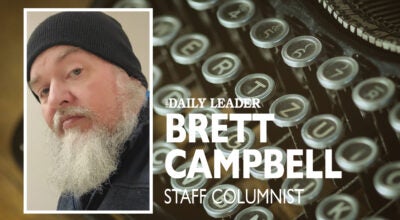Let’s talk about a disease like no … any other
Published 5:04 pm Tuesday, April 14, 2020
Writer’s Note: If any word has made a resurgence lately, it’s “quarantine.” But the truth is, whether used as a noun or as a verb, it’s really no stranger to the American vocabulary. This column is the first in a series related to a quarantine in our sister state that lasted nearly half a century.
Along the Louisiana coastline, fresh water collides with the sea to form brackish bayous, the kind that breed blue crab the size of a man’s hand and the marsh hens of John J. Audubon prints. But that salty gumbo isn’t the only improbable mix in Louisiana. This year, pro-life Democrat John Bel Edwards began a second term as governor of the red state, and state legislator Katrina Jackson, another Democrat, helped defend before the Supreme Court a pro-life bill she authored known as the Unsafe Abortion Protection Act.
Jackson’s across-the-aisle lean for life gets attention when she appears at events like D.C.’s Save the Storks Ball and March for Life, but valuing the vulnerable was an issue in her Catholic-heavy state long before Jackson, or even Roe v. Wade, made the news. For more than a century, another pro-life issue — human dignity — has been making waves behind the levees.
Where I grew up, talk of a unique colony in Louisiana sometimes crossed state lines and made it into conversations. Leprosy? Really? Yes, with a quarantined community that only in 2015 lost its last members. But patients who spent the bulk of their lives at the now-closed 350-acre leprosarium witnessed one of the biggest medical breakthroughs of the 20th century: A drug that failed to work on TB could arrest, sometimes even reverse, leprosy’s symptoms. Even so, erasing the stigma of the disease remains a challenge almost 80 years later.
That’s obvious outside the elevator at the Ochsner Cancer Center in Baton Rouge. Even though the second floor is leased to the national epicenter of leprosy care, there’s no “l” word on the wall directory. Instead, visitors search for the National Hansen’s Disease Clinical Center, a name change initiated in the 1940s that represents much more than an attempt to honor a scientist.
Inside the clinic, Simon (name changed) has flown in from Texas for a week’s worth of appointments. He’s a regular, with one of his armadillo drawings framed and hung along the maze of hallways to prove it. Using an electric scooter, the thin 46-year-old Latino maneuvers past the clinic’s pharmacy, physical therapy room, doctor’s office, and a shoe shop dedicated to making custom insoles the staff calls orthotics.
With a nod, Simon OKs a request for photos of his new finger splint, but through halting English he asks that they not include his face. After being assured they won’t, he begins relating a backstory typical among patients with Hansen’s disease.
The skin blotch deemed fungal.
Lingering eye pain with no plausible cause.
By the time Simon got a correct diagnosis in 2017, he’d shuffled between a decade of doctors, showing them aching knees, foot wounds, and spots where eyebrows used to be. A Houston hospital finally performed the test that uncovered the real cause of burns he suffered as a short-order cook. Leprosy’s nerve damage had left his fingers numb to pain.
“What’s going to happen with me in the future?” he recalls thinking as the pronouncement sunk in.
Betsy Wilks is a social worker with the National Hansen’s Disease Program (NHDP) who’s “offered a lot of Kleenex” at the Baton Rouge clinic. She says 14 years of misdiagnosed symptoms cost Simon dearly: “With early treatment, he would likely not have the handicaps he has to deal with now.”
It’s fitting that some of the staff interacting with Simon wear the tan uniforms of the U.S. Public Health Service, the little-known branch of the uniformed services that found a cure for this little-known disease. Since most American doctors have only encountered leprosy as a paragraph in a medical textbook, the Baton Rouge team conducts a yearly slate of seminars to teach signs of its slow-manifesting symptoms. Speakers clarify limbs don’t “drop off,” but instead, tissue contracts when fingers and toes are repeatedly injured, producing natural amputation. They explain that an antibiotic triumvirate — Dapsone, Rifampin, and Clofazimine — halts the disease and renders those infected non-contagious.
But if natural immunity means 95 percent of the population couldn’t get leprosy if they tried, and U.S. cases of infection seem to center around the Coastal South, why the push to educate a family practitioner in Oklahoma?
“One reason is a community of Marshallese living in the Enid area,” Wilks answers. “In the Marshall Islands, leprosy is endemic.”
Endemic may describe conditions for a fraction of the globe — pockets of Micronesia, Brazil, India and Sub-Saharan Africa — but with fewer than a thousand patients treated for leprosy in the United States last year, a budget of $13.7 million to run the Baton Rouge clinic and 11 ambulatory ones across the country seems substantial. Why do patients like Simon pay nothing for their treatment or medicines and rate free transportation, room and board during their stays? The answer may be tied to what happened at Carville.
More next week.
Kim Henderson is a freelance writer. Contact her at kimhenderson319@gmail.com. Follow her on twitter at @kimhenderson319.





